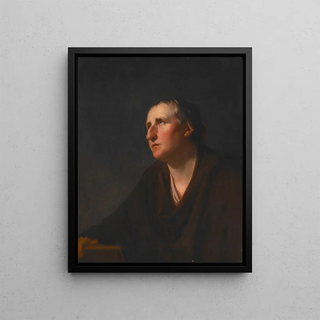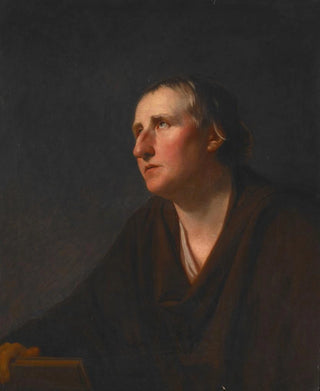Art print | Portrait of Reverend Richard Stables - George Romney


View from behind

Frame (optional)
The "Art print of Reverend Richard Stables" by George Romney is an iconic piece that immerses us in the world of 18th-century Britain. This painting, which captures not only the physical appearance of its subject but also his spiritual essence, demonstrates Romney's technical and emotional mastery. The artist succeeds in immortalizing a moment in the life of a man of faith, while infusing psychological depth into his gaze. Through this work, the viewer is invited to explore the subtleties of Reverend Stables' personality, as well as the social and religious context of the time. This portrait is not limited to a simple representation; it becomes a window into a bygone era, where art and spirituality intertwined closely.
Style and uniqueness of the work
George Romney's style is distinguished by meticulous attention to detail and a carefully chosen color palette. In the "Art print of Reverend Richard Stables," the artist uses warm, rich tones that honor the dignity of the subject. The textures of the clothing are rendered with such precision that they seem almost tangible, while the dark background highlights the luminosity of the Reverend's face. The figure's slightly tilted posture, along with his contemplative gaze, creates an atmosphere of reflection and introspection. This work is also characterized by its intelligent use of light, which accentuates facial features and emphasizes the importance of the soul in the portrait. The uniqueness of this piece lies in its ability to transcend a simple portrait to become a true dialogue between the artist, the subject, and the viewer.
The artist and his influence
George Romney, born in 1734, is one of the most renowned portraitists of his time. Influenced by the great masters of painting, such as Van Dyck and Gainsborough, he developed a style that is uniquely his own, combining realism and idealization. His innovative approach to portraiture had a significant impact on his contemporaries and paved the way for new ways of conceptualizing human representation. Romney was able to capture not only the physical appearance of his subjects but also their emotions and character, establishing an intimate connection between the viewer and the portrait.

Matte finish

View from behind

Frame (optional)
The "Art print of Reverend Richard Stables" by George Romney is an iconic piece that immerses us in the world of 18th-century Britain. This painting, which captures not only the physical appearance of its subject but also his spiritual essence, demonstrates Romney's technical and emotional mastery. The artist succeeds in immortalizing a moment in the life of a man of faith, while infusing psychological depth into his gaze. Through this work, the viewer is invited to explore the subtleties of Reverend Stables' personality, as well as the social and religious context of the time. This portrait is not limited to a simple representation; it becomes a window into a bygone era, where art and spirituality intertwined closely.
Style and uniqueness of the work
George Romney's style is distinguished by meticulous attention to detail and a carefully chosen color palette. In the "Art print of Reverend Richard Stables," the artist uses warm, rich tones that honor the dignity of the subject. The textures of the clothing are rendered with such precision that they seem almost tangible, while the dark background highlights the luminosity of the Reverend's face. The figure's slightly tilted posture, along with his contemplative gaze, creates an atmosphere of reflection and introspection. This work is also characterized by its intelligent use of light, which accentuates facial features and emphasizes the importance of the soul in the portrait. The uniqueness of this piece lies in its ability to transcend a simple portrait to become a true dialogue between the artist, the subject, and the viewer.
The artist and his influence
George Romney, born in 1734, is one of the most renowned portraitists of his time. Influenced by the great masters of painting, such as Van Dyck and Gainsborough, he developed a style that is uniquely his own, combining realism and idealization. His innovative approach to portraiture had a significant impact on his contemporaries and paved the way for new ways of conceptualizing human representation. Romney was able to capture not only the physical appearance of his subjects but also their emotions and character, establishing an intimate connection between the viewer and the portrait.






